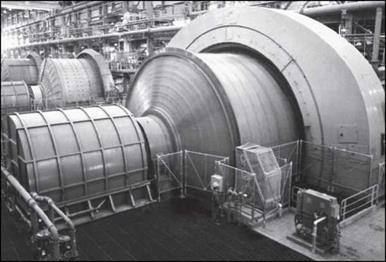Mills and the materials used to build mills have to withstand the high stresses involved in each revolution of the mill with a complete reversal from maximum compression to maximum tension and back again. Mill design required a complete understanding of the stresses involved in one rotation of the mill. As the size of tumbling mills grew, the weight of the load in the mill increased and the stress on the shell and ends (heads) increased. The rotating cylinder of a grinding mill is a balanced drum that lifts and tumbles an off-center load, where the center of gravity of the mill charge is not on the centerline of the cylinder. The weight of the charge causes a deflection of the mill cylinder. Beginning in the 1960, when electronics and digital computers were making their marks on industry, mill manufacturers were concerned with methods of measuring stresses and determining the limits of various materials of construction, and were using complex computer programs for designing mill shells and heads. X-ray methods were borrowed from physicists to look for internal defects in plates and castings.
In the 1960s, single helical drives using two or more pinions to drive one large — diameter gear were developed by the gear manufacturers for mills using 4,500-7,500 kW (6,000-10,000 hp), and they built new, larger-diameter gear-cutting facilities. Figure 7.27 shows a primary SAG mill (11 m in diameter) with a wraparound 10,000-kW motor. These motors are low-frequency synchronous motors with a controller that allows the frequency and speed to be varied, which is important in the process control system for adjusting for ore variations.
Late in the 20th century, Hardinge, Allis-Chalmers, Dominion Engineering, Marcy, and Kennedy Van Saun, all designers and manufacturers of tumbling mills, were consolidated into Svedala International’s Grinding Division. Svedala International then became part of Metso Minerals. At the start of the 21st century, the principal suppliers of primary autogenous mills are Metso Minerals, Dorbyl, Krupp Polysius (which purchased Aerofall Mills in the 1970s), the Fuller Company, and Tyazhmash.
|
|
FIGURE 7.27 Mill 11 m (34 ft) in diameter with a wraparound motor (courtesy of Metso Minerals)

